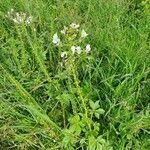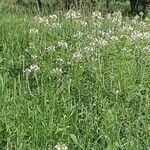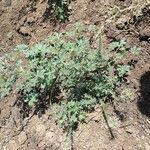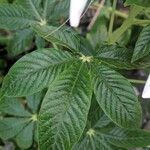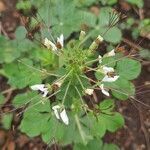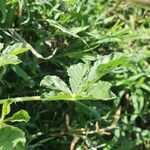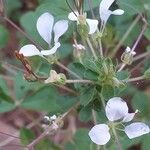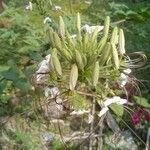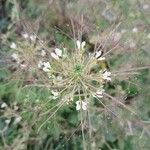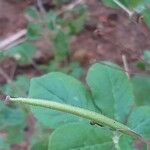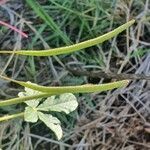Erect, mostly widely branched, annual herb, 15-80 cm. Stem glandular-pubescent to glabrous. Normal leaves with 5 leaflets, lowest and upper with 3, towards and in the inflorescence diminishing in size; leaflets thinly herbaceous, about twice as long as wide, obovate, c. 2-7.5 by 1—3.75 cm, base cuneate, top rounded arid ± distinctly acuminate, ciliate to denticulate; nerves 5-8 pairs; petiole 2-10 cm, petiolules 1-3 mm, webbing at the base, densely glandular puberulous. Flowers in long, corymbose racemes, nocturnal. Pedicels thin, 1½-2½ cm, glandular-puberulous. Sepals 2½-5 by 0.5-1.5 mm, acute, puberulous, ciliate. Petals with open aestivation, all pointed upwards towards the adaxial side, elliptic with narrowed base and rounded top, 1.5-5 mm stalked, 7-15 mm long in all, 1.5-4 mm broad. Androgynophore 9-16 mm. Stamens 6; filaments 1.5-2 cm; anthers linear, 2-3 mm long. Gynophore 1-2 mm; ovary cylindric, c. 3 by 0.5 mm, in some flowers (especially the apical ones) sessile and reduced. In fruit pedicels 1-3 cm, androgynophore 13-20 mm, gynophore 4-10 mm. Fruit cylindrical, tapering to both ends, 2-11 cm by 3-4(-6) mm; beak 1-4 mm; valves with longitudinal, centripetal veins. Seeds depressed-globular, c. 1 1/3 mm diam., with a shallow and narrow cleft, black-brown, with many superficial concentric ribs and numerous irregular distinct cross-ribs. No elaiosome.
Erect, annual herb, to 1.3 m high, glandular-pubescent, unarmed, foetid. Leaves 3–7-foliolate, petiolate; petioles to 10 cm long; leaflets oblanceolate, elliptic or rhomboidal, acuminate to acute, sometimes rounded annd apiculate; to 7 cm long, 4 cm wide; entire to irregularly dentate, glandular-ciliate; surfaces glabrous to glandular-pubescent especially along abaxial venation. Inflorescence a bracteate raceme. Sepals elliptic to obovate, 3–6 mm long, glandular-pubescent. Corolla open in bud; petals 6–20 mm long, claw c. ½ of length; lamina broadly ovate to suborbicular, white or pink, sometimes yellow or purple. Stamens 6; filaments fused basally to gynophore; androgynophore c. ½ of gynophore; all lengthening greatly following anthesis; anthers 2–3 mm long, straight; androgynophore to 25 mm long, glabrous; free filaments to 25 mm long. Ovary glandular-pubescent. Siliqua linear, straight to curved, erect to spreading, 4–10 cm long, 3–6 mm wide; pedicels 12–25 mm long; gynophore to 20 mm long; valves finely longitudinally striate, glandular-puberulous; stigma subsessile to sessile. Seeds suborbicular, 1–1.5 mm long, rugose to tuberculate; cleft open to closed but not fused; aril absent.
An annual herb. It grows to 0.6-0.9 m. It has a long tap root. It is erect and somewhat hairy. It usually has purple stems. The leaves occur one after another along the stalk. The leaf stalk is long. There are 5-7 leaflets which are unequal and spread out at the end. They are oblong and about 2.5-6 cm long by 1.4-3.2 cm wide. The leaflets are pointed at the base and a rounder near the tip with a rounder point at the tip. There are fine teeth along the edges of the leaves. The flowers are white or purple They occur in long flower clusters at the end of branches. These are 30 cm long. The flower clusters are showy with white or purplish flowers and a spidery like appearance. The fruit are a slender capsule with 2 valves and with many small seeds. They are 5-10 cm long and very narrow. The seeds are kidney shaped and rough. They are brown and have fine lines along them. They are 1-1.5 mm across.
Annual herb, 0.25-0.60 m high, erect, much branched, sometimes becoming woody with age. Stems striate, viscid glandular-pubescent to glabrescent. Leaves petiolate; 3-5-foliate, leaflets obovate to oblanceolate, glabrescent to finely glandular on the under surface, often with scattered multicellular hairs on the main nerves below, margins repand-denticulate. Inflorescence a terminal raceme. Sepals lanceolate-acuminate, glandular. Petals white, obovate-oblanceolate. Stamens 6; filaments purplish. Ovary linear-oblong, glandular. Fruit a linear capsule, style persistent. Seeds brown, circular.
Annual herb, up to 0.6 m high. Stems erect, viscid glandular-pubescent to glabrescent. Leaves 3-5-foliolate; petiolate; blade obovate to narrowly obovate, terminal leaflet up to 40 x 20 mm; petiole 20-50 mm long, glandular-pubescent. Flowers: stamens borne on long androphore, well exserted from corolla; petals obovate, 10-20 x 3-5 mm, white to rose-pink; Nov.-Apr. Fruit 30150 x 2.5-5.0 mm; seeds brown, circular, obscurely reticulate-rugose.
Erect annual herb, up to 250 mm tall. Stems glabrous. Leaves 3-foliolate; leaflets linear-filiform. Petals 5-8 mm long. Flowers pink to mauve.
